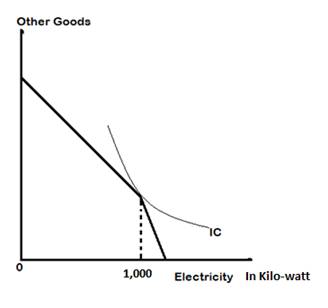
To discuss the preference of consumer with the change in the price of electricity after a certain unit of consumption
Explanation of Solution
Budget Constraint: It shows all the possible combination of two goods that a consumer can purchase, given the level of income of consumer and market prices.
The budget line rotates (inwards or outwards) with a change in the price of any of the two goods and the budget line shifts (inwards or outwards) with a change in the income of consumer.
On the consumption of the first 1,000 kilowatt units of electricity, the consumer is charged $0.10 per kilowatt.When the consumer consumes more than 1,000-kilowatt units, the consumer is charged $0.15 for each extra kilowatt.
This price change over 1,000 kilowatt makes use of electricity more expensive and makes the consumer budget line steeper after the consumption of 1,000 kilowatts of electricity.
This will change consumer preferences regarding consumption of electricity and consumer will try to consume up to 1,000 kilowatts to maximize his/her utility.
As shown in the below diagram the consumer is maximizing his utility at the consumption of 1,000 kilowatts of electricity.

Want to see more full solutions like this?
Chapter 2 Solutions
EBK INTERMEDIATE MICROECONOMICS AND ITS
- Complete the following table and answer the questions below: Units Consumed Total Utility Marginal Utility 0 0 — 1 10 10 2 8 3 25 4 30 5 3 6 34 a. At which rate is total utility increasing: a constant rate, a decreasing rate, or an increasing rate? How do you know? b. True or False. “A rational consumer will purchase only 1 unit of the product represented by these data, because that amount maximizes marginal utility.” c. True or False. “It is possible that a rational consumer will not purchase any units of the product represented by these data.”arrow_forwardthis week you have gone to two parties. assume the total utility you gained from these parties is 100 utils. then you go to a third party, and your total utility rises to 110 utils. what is the marginal utility of the third party attended per week? given the law of diminishing marginal utility, what will happen to total utility and marginal utility when you go to a fourth party this week?arrow_forwardA consumer currently spends a given budget on two goods, X and Y, in such quantities that the marginal utility of X is 15 and the marginal utility of Y is 8. The unit price of X is $3 and the unit price of Y is $2. The utility-maximizing rule suggests that this consumer should Multiple Choice a. decrease consumption of product X and increase consumption of product Y. b. increase consumption of product X and increase consumption of product Y. c. decrease consumption of product Y and increase consumption of product X. d. stick with the current consumption mix because it yields maximum utility.arrow_forward
- Suppose John decides to buy 4 units of food and 4 units of clothing with his $12 budget. Would his marginal utility per dollar spent on food be greater than or less than his marginal utility per dollar spent on clothing? What does this tell you about how he should substitute food for clothing if he wanted to increase his utility without spending any more money?arrow_forwardRefer to the table below. If the subscription price for a sports app is $2 per week, the subscription price of a game app is $1 per week, and a student has $9 per week to spend, what quantities will she purchase at a consumer optimum? Quantity of Sports Apps per week Marginal Utility (utils) Quantity of Game Apps per Week Marginal Utility (utils) 1 1,200 1 1,700 2 1,000 2 1,400 3 800 3 1,100 4 600 4 800 5 400 5 500 6 100 6 200arrow_forwardComplete each of the following sentences: Your tastes determine the _____________ you derive from consuming a particular good. _______________ utility is the change in ________________ utility resulting from a _______________ change in the consumption of a good. As long as the marginal utility is positive, total utility is ____________________________. The law of diminishing marginal utility states that as an individual consumes more of a good during a given time period, other things constant, total utility ________________________.arrow_forward
- Define Economic utilityarrow_forwardRaymond consumes meatloaves and pineapples. He has decided that his monthly budget will be $1500. Suppose that one meatloaf costs $375, while one pineapple costs $150. c. Show how Raymond’s budget line changes if the price of pineapples increases to $370. d.. Suppose Raymond decides to cut his monthly budget in half. Coincidentally, the next time he shops, he learns that meatloaves and pineapples are on sale for half price. Show what happens to Raymond’s budget line?arrow_forwardWhen the consumer buys 60 units of quantity of goods at a price of 3 per unit what would be the total expenditure!!!!arrow_forward


 Economics (MindTap Course List)EconomicsISBN:9781337617383Author:Roger A. ArnoldPublisher:Cengage Learning
Economics (MindTap Course List)EconomicsISBN:9781337617383Author:Roger A. ArnoldPublisher:Cengage Learning






